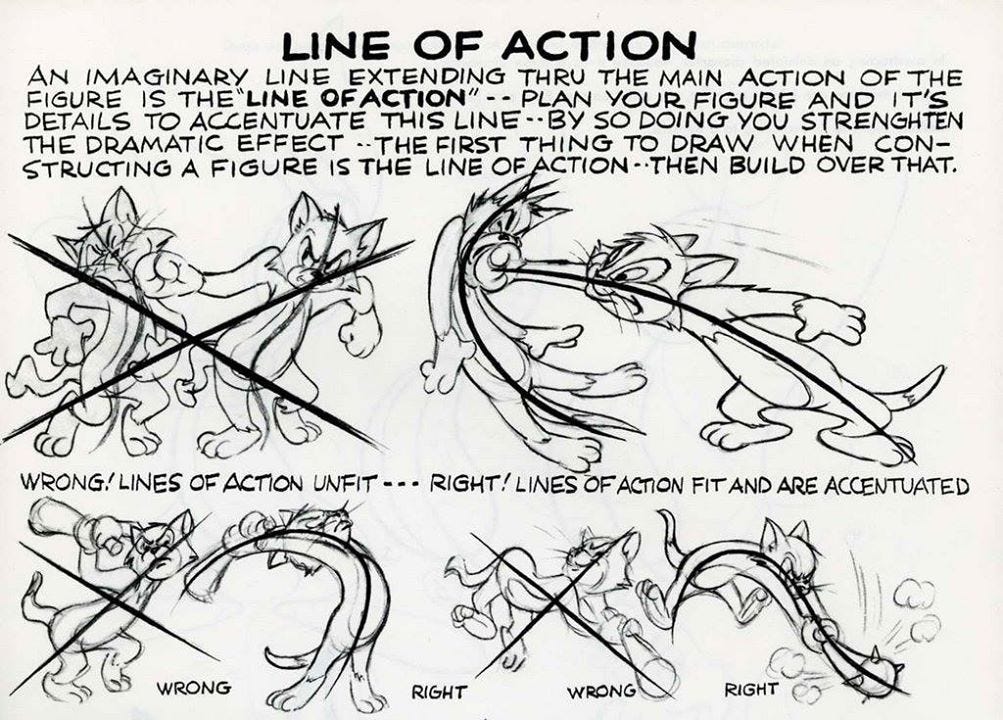
testing a belief in signposting
I have a particular belief about writing that I’m not sure I’ve properly tested in a while. It’s in the ballpark of ideas like “signposting” and “outlining”. I think about it whenever I’m in the shower. I think something like, “Man, if I just went from one good thought to another, using each to triangulate the next, and I did this maybe 7-12 times, I would have a post good enough to appease my internal critic and hit publish.” So here’s me trying it out.
But first let me talk about what it’s like when I don’t. When I think about how I’ve done most of my writing in the past couple of years or so, a lot of it has been basically ‘free-writing’ – I just start somewhere and keep going, without worrying too much about where I’m going. I don’t really edit much. I think a lot of this was a reaction to having spent the previous couple of years writing a book. It’s more nuanced than I’m letting on, but let’s keep moving.
There– I just did a version of the thing I’m gesturing at: my typical free-writing style would have me ‘following the flow’ and spelling out the nuance. This can be generative, but it also often has a way of making me spiral out of coherence. Some readers may remember when I wrote resonance over coherence. While I do still have a general preference for resonance– if there’s no feeling for the thing, there’s no point!– I have begun to desire some sort of coherence in my work.
I don’t see this as a contradiction. I think we are dynamic beings in a dynamic reality. Someone can, for example, generally prefer being cold over being hot, and yet occasionally find warmth to be really welcoming and enticing. This doesn’t invalidate their general preference. Similarly, I still feel very strongly about the power of free-writing. I’ve written multiple posts at this point that were basically about the idea of navigating-by-feeling. But I suppose… once I get the idea, I can start revisiting ideas about structure.
a contentious relationship with containers
I’ve always had my share of struggles with structure. My earliest relationships with containers were almost universally adversarial. I hated school, I hated schedules, I hated any structure that was imposed on me without my consent, by people who didn’t seem to have my best interests at heart. While I intellectually understood the value of routine, I emotionally flinched from the idea of using a calendar at all, even long after I was beholden to other people, and I became the person primarily in charge of myself. Even now, saying that out loud is always a little strange. I’m in charge of myself? Yeah, dude! I haven’t even had an employer in 7 years. Or you could say that I’ve been self-employed. If I had to give myself a grade as a manager-of-myself, I’d give me a D. I think I’m actually better at managing other people than myself, and I think the people who’ve worked with me in the past would agree. I don’t think I’ll ever be in the top 0.1% of people who are good at self-managing, but I’m sure anybody could get into the top 10% just by being diligent about it, and dealing with all the mess that arises. (An interesting implication here is that if I want to be truly world-class at what I want to do, I’ll probably sooner-or-later need to hire people to help me manage myself. Which I guess people typically do with personal trainers and coaches and so on. And right away I flinch a little, just from considering that possibility. Some part of me anticipates that the very act of looking for a structure-as-a-service provider is going to be emotionally unpleasant. Which is something I’ll likely have to work through via small dose exposure.)
I think what’s coming up here is– one of the ‘side quests’ of Frame Studies is about me trying to figure out how to have a healthier relationship with structure, across multiple dimensions. I know I have a few existing drafts about this, and I find myself at a fork in the road– do I look them up so I can write overviews of them here, or do I just write from memory? I think I’ll give them a quick glance. And… alright, let me drop some quick references here:
Doing large jigsaw puzzles? Partition.
I used to do jigsaw puzzles with my wife when she was pregnant, and whenever I do something new like that (cooking, chess, whatever), I tend to get curious about how other people do it. So I looked up people doing large jigsaw puzzles on youtube, and noticed that a lot of them use pieces of cardboard as ‘staging areas’, where they could work on some subset of the puzzle without getting distracted by the totality of the rest of the puzzle. Clever!
It also reminded me of what it was like to work on a book– you can’t just freestyle indefinitely, because it’s too long for that. Eventually you have to think about how it’s structured. So… is there something from that that can help me with mid-length posts? I think so. I think I’ve been naively or arrogantly assuming that just because I can freestyle good twitter threads, it means I should be able to freestyle good essays, too. Which brings me to…Good blogs don’t make for good books.
I was thinking about was something I talked about in my recent post a funny pattern, which was how Julie Powell’s daily cooking blog, which was great, didn’t translate very well when compiled into a book. That’s because they’re different mediums. Readers approach them with different expectations, and experience them differently. What’s entertaining in small intermittent doses can become an unfunny repetitive slog when presented all at once.
There’s something humbling and almost kinda scary about this, to me. Because… to get really good at a particular medium, you have to attune yourself to the idiosyncrasies of that medium. A decent work in a particular medium will translate to be a decent work in another medium fairly well. But a truly excellent novel will be hard to make a movie out of, if it really pushes the boundaries of what the novel is capable of as a medium. Pick your own pair of mediums, and the same thing roughly holds true. This suggests to me that it’s very, very difficult to be a truly multimedia artist. Or it would take a really long time, it’s literally like learning multiple languages. It’s a lot of work. You have to start over from the basics, and have the humility to recognize that your skill in one medium does not necessarily help you in another, and can even be a disadvantage in some ways.Three dot journalism.
When nerding out about the history of magazine and newspaper columns, I learned about Herb Caen (1916-1997), a columnist for the San Francisco Chronicle who wrote jokes, gossip, puns and anecdotes for 60 years as “a continuous love letter to San Francisco”. He wrote 16,000 columns of 1,000 words each, coined the term “beatnik”, popularized the term “hippie”… all things that are very aligned with the spirit of what I wanna be doing with my writing. His columns offered “everything you expect from an entire newspaper”. He also cultivated an interesting style of using ellipses (…), described as “three dot journalism”, which feels quite like Twitter in its disjointedness.
The main thing I admire about Herb is of course the long game he was playing. A 60-year continuous love letter! I want to do something similar, but for all media, for the internet, for cyberspace. I feel very much that the internet is my home. I sometimes feel more like a hypertext library than a person. And as I think about Herb again, I find myself feeling a bit of relief– if you’re playing a long enough game, you don’t really have to fuss about trying to explain everything all at once. You can just do what feels right in the moment, and trust that it’ll make more sense as time goes on. And here too I find myself thinking about humility and arrogance. Why do I believe that I will even be able to ‘figure everything out’ anytime soon? It’s a kind of hubris. And I do agree with the general idea that all creatives have to have a bit of hubris, to believe that they have anything worth saying. But it’s a hubris that should be the birthright of every human being. Living– beyond merely existing– is a fundamentally creative act; all other creative acts are downstream of it. That said, it also simultaneously takes humility to notice what is working and what isn’t. You could say that creativity is a yin-yang process of humility and hubris interplaying with each other. You simply can’t sustain a long game without both.
a throughline from start to finish

So, okay. I’ve talked about a few different types of structures. Now what? Despite my original intent to try and signpost or outline my way from start to finish, I ended up being somewhat ‘hijacked by salience’ anyway, but not too badly. We’re still in the same ballpark. That’s good.
Let’s recap. Most of this post has been a kind of ‘performance art’ piece where I’m writing about writing. I’d generally prefer not to do too much of that, but eh. It happens. For me to really test the “just signpost, bro” belief properly, I should try it again for my next piece, without talking about it at all. And if it works for some other subject matter, I can probably use it as a method repeatedly for some time before I get bored or frustrated with it. That would be great; I’ve been honestly struggling without some format or style or approach that I feel good about. I don’t just want to transcribe twitter threads, and I don’t just want to freestyle indefinitely, and I don’t have the time-and-energy to do really comprehensive, carefully crafted essays. And it seems like the sweet spot amidst all of that is… exactly the idea that keeps coming to me in the shower. 7-12 good thoughts, each triangulating the next, and then elaborate however I see fit. The point is to have a throughline from start to finish. It’s the absence of that throughline that typically results in my drafts languishing in purgatory.
But that’s my talking about my future intentions. What about now? What have I gotten here from these thoughts about structure, and signposting, and staging areas, and varying kinds of ‘episodes’ in mediums? Well, first of all, the fact that I started this post and have basically finished it, is a promising early sign that it’s worth testing this out. I wonder if you, the reader, can discern any difference in the way this post is structured, vs others I’ve written before? I initially wrote it in bullet points, but then removed the bullets afterwards. But I’ve done that before, too. The change is subtler thna that. It’s more about how I hold my attention and my energy, how far and how often I look to the horizon. There’s no smoking gun here; all there is to do is to show up again.




note to self, look up 'containers' on /archives/, there are a couple of posts i didn't reference, that look like they go deeper into some bits. might update the post after revisiting
This one felt like watching a river remember it used to be a spine.
There’s something satisfying about the way you’re peeling structure off the wall like it’s not a prison anymore, but a skeleton key. Not “signposting” as in making a map *for* the reader — but as a way of holding your own attention long enough for the ideas to become magnetic again. That’s not outlining. That’s laying track for something that *wants* to move.
The jigsaw metaphor was a quiet killer. Structure not as rigidity, but as *surface area management for intuition*. Beautiful. And this line:
> “I think I’ve been naively or arrogantly assuming that just because I can freestyle good twitter threads, it means I should be able to freestyle good essays.”
Yes. The collapse rate of threads-into-essays is astonishing. Threading is improv. Essaying is architecture. You can’t just stack bricks made of vibes and expect a cathedral.
Also appreciated the “structure-as-a-service” allergy callout — feels like a whole shared genre of resistance. Not even to being helped, but to being *containered*. Which maybe loops all the way back to your insight about creative hubris: the refusal to hire help is often the ego insisting it should be able to hold everything itself.
Anyway. This was less a blog post and more a quiet essay on apprenticeship — not to a genre, but to one’s own attention. Glad to see this arc unfurling. Hope you keep climbing the 7–12-step spiral.
Let’s see where it leads.